What really happened…
Okay, depending on your tastes, our tour through the never-built rides of the Disney-MGM Studios may leave you heartbroken for what we lost… or happy to return to the Studios you know. To be fair, Disney’s super-charging of the Disney-MGM Studios in the ’90s and 2000s did happen, yeilding a park that’s certainly uneven, but that’s almost entirely made up of E-Ticket headliners!
So since we know that none of the attractions in “Possibility Studios” actually came to be, the question becomes… why not? Let’s revisit each of these attractions one-by-one to explore the real stories behind these cancelled could-be blockbusters…
1. Roger Rabbit’s Hollywood

Despite relatively little being known about Roger Rabbit’s Hollywood, fans have a good sense of why it never came to be. For one thing, Disney doesn’t wholly own 1988’s Who Framed Roger Rabbit?. To finance the risky, $50 million picture, the Robert Zemeckis film was co-produced by Steven Spielberg and his Amblin Entertainment. It’s said that Eisner and Spielberg developed a contentious relationship surrounding ownership of the film’s characters and their use in the parks. But an equally likely story is that the Disney Renaissance simply supercharged Disney’s catalogue with fresher films to inject into the Studios.
That’s too bad, because a 1990 “Disney Decade” press release had already announced that parts of the mini-land would make their way to Disneyland, too. In a cul-de-sac jutting east off of Main Street (once reserved for two never-built lands dreamed up by Walt), the new Hollywoodland would take shape. California’s land would not only house the zippy Runaway Baby Buggy dark ride and Toontown Trolley, but also a copy of the Lost Legend: The Great Movie Ride.
Since this Hollywoodland would be nestled into the base of Space Mountain, the sloped peak would be disguised from within as the rolling Hollywood Hills, complete with Hollywood Sign!
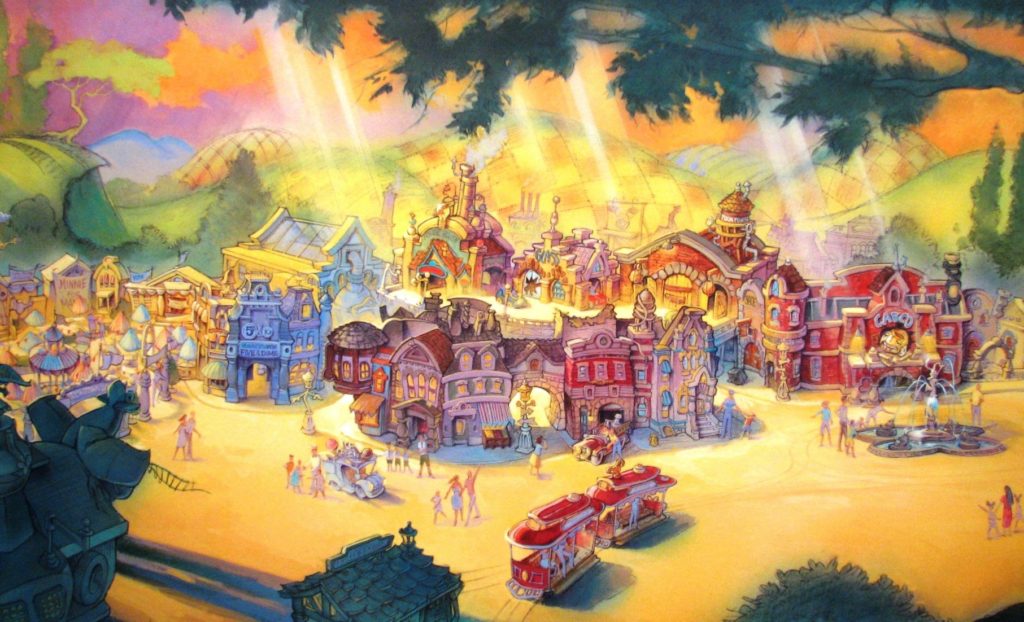
Neither the Studios’ Roger Rabbit land nor Disneyland’s Hollywoodland came to be, but Roger Rabbit did get his very own land… in a sense. When Disneyland’s Toontown debuted in 1993, the land was stylistically based on the Fleischer cartoon style of Roger Rabbit, and Roger Rabbit’s Car Toon Spin was the land’s starring dark ride. Who Framed Roger Rabbit?, meanwhile, remains a fantastic ’80s classic, but has largely been left out of the pop culture prominence that Disney’s enduring ’90s Renaissance films have enjoyed.
2. Dick Tracy’s Crime-Stoppers
Unlike in Possibility World, in the real Disney-MGM Studios, the tepid response to 1990’s Dick Tracy film cooled any pursuit of a dark ride. It’s the double-edged sword of the studio park… If you wait to see if your film’s a hit, you’re too late to build an attraction; build too soon, and you might theme a ride to a flop. If Crime-Stoppers had gone forward, it would likely be a favorite ride today far moved from its source material. But it didn’t. Which isn’t to say that Dick Tracy was never brought to life in the park…
3. Hotel Mel
We’re guessing you know what became of Hotel Mel. Though Disney and Brooks toyed with the idea, it’s reported that neither party was ultimately happy with the end result. No one could quite figure out the tone of the ride… Was it funny, or frightening? Were guests “extras” on set, or trapped in the hotel? Were the monsters actors on set, or was the hotel really haunted by ghouls? (The description we gave was “funny,” “extras,” and “actors” respectively, but try any combination in your head!)
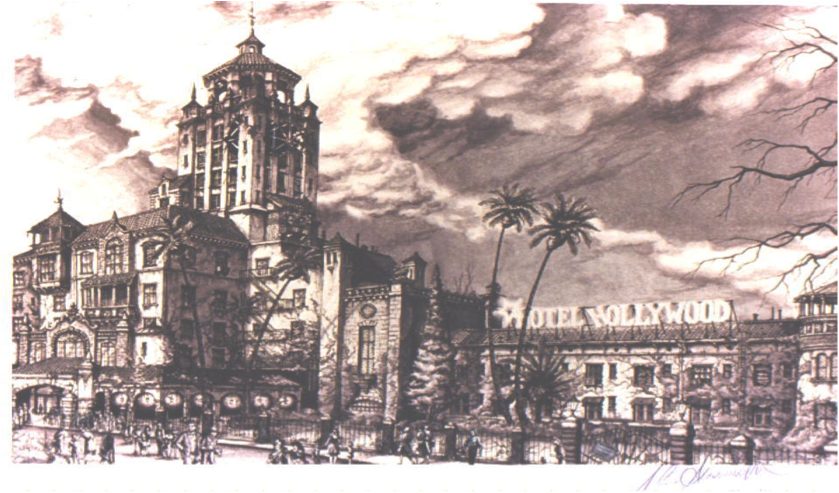
Though Hotel Mel was abandoned (no pun intended), the idea of a derelict Hollywood Hotel merged with Eisner’s call for more thrills, and Imagineers’ concept of using an Intamin First Generational Freefall drop tower (once planned for the never-built Discovery Mountain).
Thankfully, Disney didn’t activate on the rudimentary ride system (which would seem entirely barbaric by today’s standards, with elevators rattling down a metallic scaffold tower and sliding out at the bottom with riders ending up on their backs). Instead, they held out for a more advanced ride system and an IP that perfectly balanced “horror” and “sci-fi” without any blood or gore. Yep, we traced the full story of Hotel Mel’s transformation into one of the era’s best rides in the Modern Marvels: The Twilight Zone Tower of Terror feature.
4. Copperfield’s Magic Underground
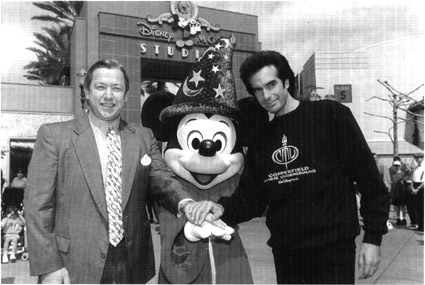
Our friends at Theme ParkUniversity detailed the entire story of Magic Underground’s rise and fall, but it mostly came down to finances that had nothing to do with Disney. The Times Square location had raised $20 million through investors and had begun construction when Copperfield allegedly stepped in. He wanted more control over the attraction to ensure his brand and illusions were respected, necessitating major changes halfway through the process. To raise more money, the company turned to Prince Walid bin Talal of Saudi Arabia (the same prince who effectively owned controlling shares of EuroDisneyland).
Ultimately, the Time Square location was reportedly 85% complete and $34 million in the hole when construction stopped. No earth had been moved in Orlando, making the project easy enough to cancel outright. We’ll leave it to you to decide if Magic Underground would still be around today even if it had been built.
5. Muppet Studios
By all accounts, Jim Henson liked the idea of selling The Muppets to Disney and the promise of taking on a creative role for the brand rather than a business one. However, Henson died unexpectedly on May 16, 1990 – just a year after the opening of the Disney-MGM Studios. The Henson family quickly rallied and retracted, pulling out of the relationship with Disney.
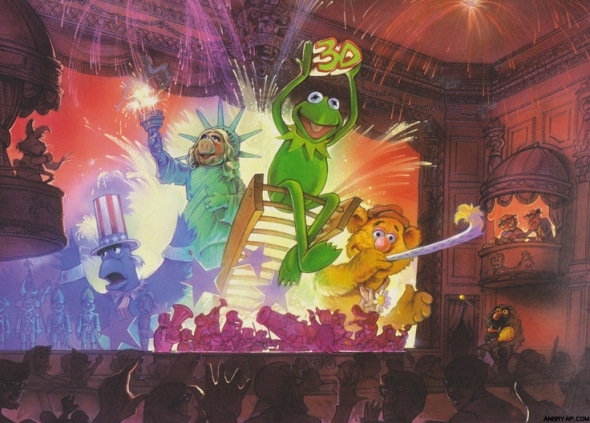
In fact, the Henson family allegedly sought to scrap Muppet*Vision until legendary Muppeteer Frank Oz screened the finished film for the family and begged them to allow the world to see Jim’s last project. Muppet*Vision ended up debuting on May 16, 1991 – the first anniversary of Jim’s death. It took more than a decade, but in 2004, Eisner finally oversaw the acquisition of The Muppets, launching two theatrical films, the Muppet Babies TV series, a few parks appearances, the Muppets Now Disney+ series, and a short-lived Muppets Courtyard rebrand at Disney’s Hollywood Studios.
As a matter of fact, we traced the full facts behind the park’s “Muppetational” never-built land in a full, standalone Possibilityland: Muppet Studios feature – a great place to dig deeper into the story!
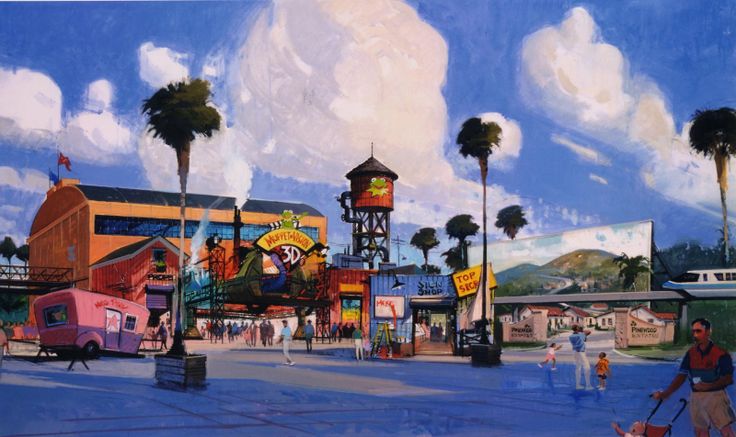
When Disney California Adventure opened in 2001, a good portion of its “backlot” section was themed to the Muppets (above), but it’s long-gone today. Muppet Studios – and in particular, the Great Muppet Movie Ride – feel like attractions that would still make sense at Disney Parks. But since the acquisition of The Muppets was immediately overshadowed by Disney’s purchase of Pixar and the ensuing Pixarification of Disney Parks (then Marvel, then Star Wars, and then 20th Century Studios), chances of a big budget Muppets resurgence are slim to none…
6. Monsters Inc. Door Chase coaster
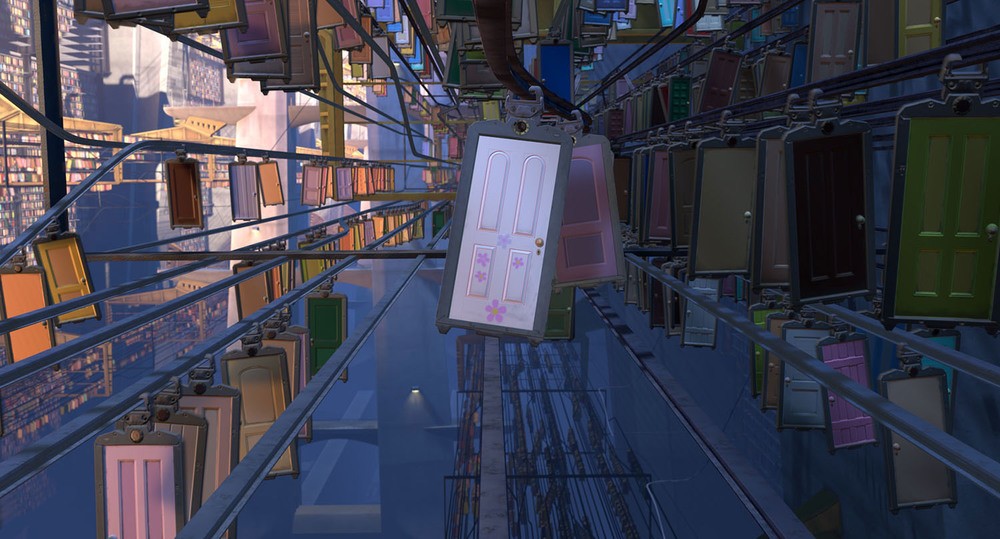
A suspended family coaster based on Monsters Inc. was one of the longest-running rumored projects in Disney Parks history… In fact, insiders seemed so sure that the coaster was coming that it practically ranked among Disney’s “worst kept secrets.” Until it didn’t happen, of course…
Then-Vice President of the resort Dan Cockerell later discussed the never-built project with WDWRadio. There, he confirmed that though the attraction was in development (and spearheaded by Pixar’s then-COO John Lasseter), it just didn’t fit the needs of the Studios at the time, which Cockerell percieved as more family-friendly attractions to balance existing thrills. The death of the Door Chase was likely sealed when Disney acquired Lucasfilm in 2012, unthinkably surmounting Pixar to become the must-have brand of any extensive Hollywood Studios reimagining.
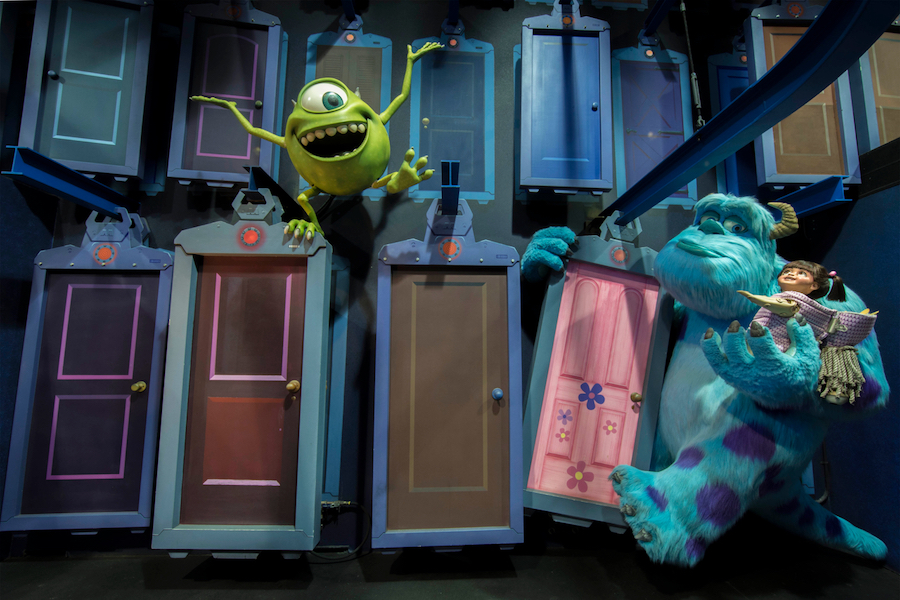
Cockerell’s refusal of the Door Chase coaster concept in Florida probably also knocked down a second domino: plans to duplicate the ride in California. In the early 2010s, insiders were certain that that formerly-Muppets-themed leftover “backlot” section of Disney California Adventure’s Hollywood Land (the only area not touched during the park’s five-year reimagining) was set to become a full Monstropolis land with the Door Chase as its centerpiece… but we’ll save that for a Possibilityland tour through the California Adventure that never was…
7. Backstage Studio Tour
While Imagineers were developing plans to evolve the Backstage Studio Tour and continuously grow its offerings, they faced a major issue: the Disney-MGM Studios’ backlot wasn’t growing; it was shrinking. Right off the bat, it became clear that the “real, working” movie studio constructed for the park wouldn’t turn Orlando into a “Hollywood East.” The New York Street set (once accessible only via the tram) was opened to pedestrian traffic just to alleviate the pressure of crowds, beginning the shortening of the Studio Tour.
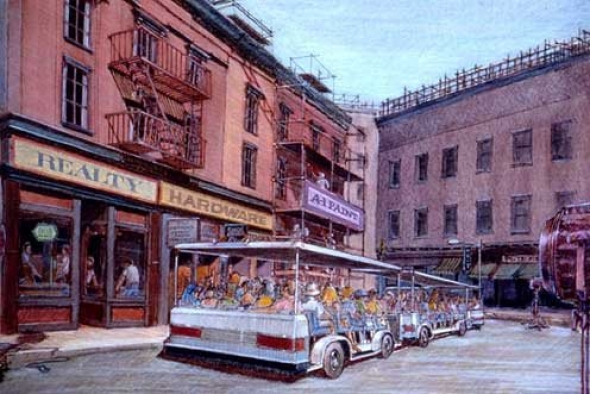
Simultaneously, evaluation suggested that while folks liked the Disney-MGM Studios, they unanimously agreed that it needed more rides. Suddenly, “plussing” the Studio Tour felt like a fool’s errand. Instead, all resources were shifted toward Sunset Blvd. and its projects (like Roger Rabbit’s Hollywood, Dick Tracy’s Crime-Stoppers, Hotel Mel, and later the Twilight Zone Tower of Terror) which would add rides and capacity.
What’s more, Michael Eisner reportedly didn’t like the early scripts drafted for a Journey to the Center of the Earth movie and quietly cancelled the film, meaning a tie-in on the Studio Tour wouldn’t be worth its development costs.
As we know, the Studio Tour continued to shrink year after year after year, embarassingly outlasting any semblance of actual moviemaking by decades – a story we told in our Declassified Disasters: Backstage Studio Tour feature. But as they say, “good ideas never die at Disney.”
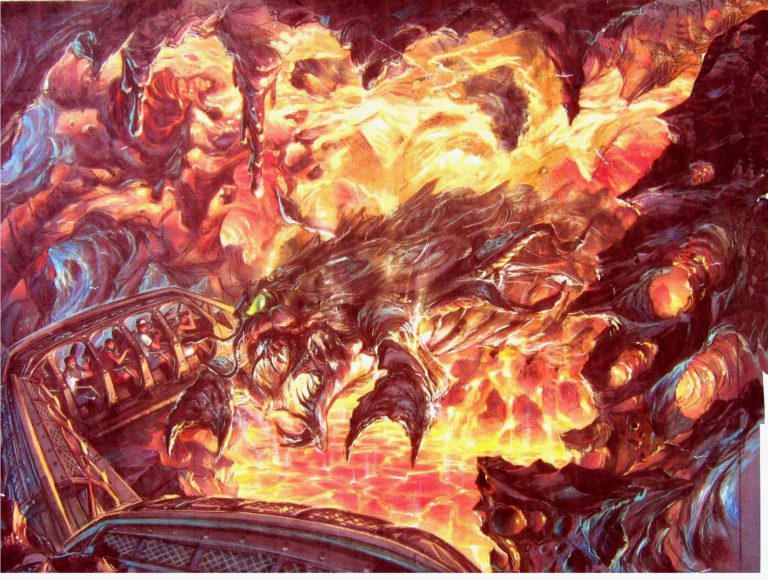
Imagineer Scott Sinclair and his plans for the deep-earth encounter were brought along to the team designing Tokyo DisneySea’s Modern Marvel: Journey to the Center of the Earth, resulting in what many call one of Disney’s best modern dark rides… thanks in part to its molten encounter with one of the best Audio-Animatronics on Earth.
Possibility Studios
Movies are all about making the impossible real… so it’s only fair that Disney’s Possibility Studios makes real all of the never-built attractions that could’ve been stars… Without a doubt, some of these never-built projects would still make sense today! Others were clearly of their time. Some would probably have weakened the park more than helped it… And therein lies the fundamental flaw in the studio park style: how do you bring blockbusters to life when the box office always moves on? How do you make a park feel evergreen when films and celebrity stars are part of its foundational identity?
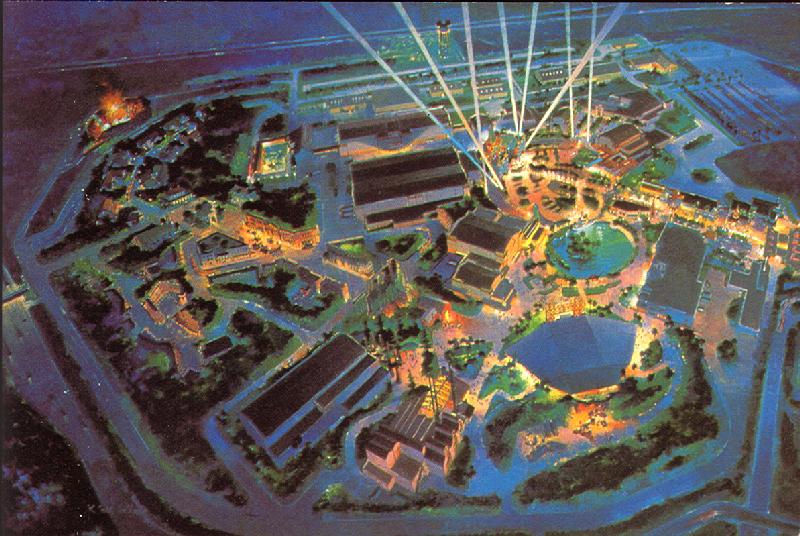
So while fans may daydream about the never-built projects of yesteryear, perhaps our tour through Disney’s Possibility Studios is a wake-up call… The grass isn’t always greener. The real Disney’s Hollywood Studios may not be a perfect park, and several of these projects might have made it stronger in their respective times or even unto today… but frankly, the push and pull of Hollywood is destined to make any “studio” park subject to the whims of pop culture anyway.
Put another way, even if the never-built attractions we detailed here had come online, they’d likely be overlayed with Marvel, Pixar, or Princesses by now, anyway, if they wouldn’t have already been bulldozed. And that’s the heartbreak and the fun of Possibilityland, where’s anything’s possible…

Thank you so much for reading. Now, it’s your turn to join the story. If you enjoy spending time falling down the “rabbit hole” of Park Lore’s in-depth, ad-free, member-supported stories, consider becoming a Member for as little as $2 / month.
Members can unlock rare concept art in every tale, reveal attraction audio streams in select stories, gain access to over a hundred exclusive articles in our quick-read Extra Features and in-depth Special Features collections, gain exclusive podcast extras, and receive an annual member card and merch in the mail! (Plus, y’know, supporting research-based, ad-free, clickbait-free, in-depth theme park writing!)




